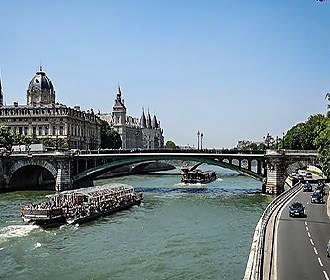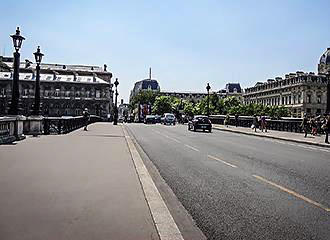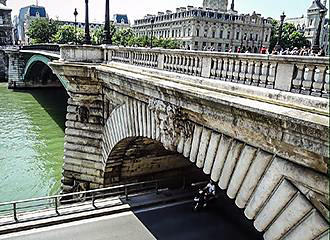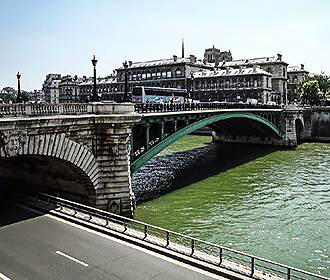Pont Notre-Dame bridge in Paris
Connecting the right bank of the River Seine to the Ile de la Cite island, the Pont Notre Dame is situated at one of the most historical crossing points of the river, yet what you see today is not how this original bridge in Paris was constructed.
A bit of history
The widest stretch of the River Seine has had a bridge at the point where you can now see the Pont Notre-Dame going back many centuries, and in ancient times it was called the Grand Pont.
However, in the 9th century during the Norman invasions, the bridge was replaced with another bridge called the Planches de Mibray, and the reason for its name was due to having large planks laid down that covered the marshy ground on the approaches either side of this old bridge in Paris.
Eventually this particular bridge was swept away by floods at the start of the 1400s, but in 1413 it was King Charles VI that ordered the construction of a new bridge to be called the Pont Notre-Dame. So under these orders a new wooden bridge was constructed, that had around sixty houses built on it, which became famous for its bookshops, but several decades later, even after a carpenter advised of its poor state, this bridge collapsed in the October of 1499.
Eight years later a new Pont Notre-Dame was constructed with six arches, and this again had houses built on it, and it was this bridge over the River Seine that was renovated in the 1600s and decorated to honour the arrival of Marie-Therese of Austria, wife of King Louis XIV.
Later on, the Pont Notre-Dame had its houses demolished and removed in 1786, yet this strong bridge was still standing, that is, until 1853 when a decision was made to construct a new stone bridge with five arches.
About the Pont Notre-Dame
The new Pont Notre-Dame bridge with its five stone arches was constructed in 1853 by Gariel using the foundations of the previous bridge.
However, it was not an easy bridge for boats and cargo vessels to negotiate and for the period of twenty years up until 1910, there were no less than 35 reported accidents, which meant that it got the nickname of Devil Bridge.
And so, in 1912, the decision was made to replace the middle section of the Pont Notre-Dame with a metal arch of one single span that would join to the stone arch on either bank, and this was finally inaugurated in 1919.
You will however find there is still a carved stone head on each of the arches, and these are meant to represent Dionysus, who was a Greek God in mythology.
Visiting the Pont Notre-Dame in Paris
The Pont Notre-Dame goes from the Quai de Gesvres on the right bank of the River Seine over to the Quai de la Corse on the Ile de la Cite island and you will find that the next bridge upstream is the Pont d’Arcole, and the next bridge downstream is the Pont au Change.
You will find that this is a traffic bridge, yet also has a 4m wide pavement on either side for pedestrians, and the nearest Metro station to the Pont Notre-Dame bridge is called the Cite stop on the Ile de la Cite via line 4. Alternatively, you have the Hotel de Ville Metro stop via lines 1 and 11, yet the bus tours in Paris such as l’OpenTour also have a stop close by as well.



